The College Park City-University Partnership announced today a homeownership program to incentivize university employees to live in the city.
The program will provide $15,000 zero-interest, 10-year loans to regular, full-time, benefits-eligible university employees to help cover a city home’s down payment and closing costs, according to the program document.
The city’s median home value is $273,100, according to the U.S. Census Bureau, meaning the new loan program is “just a drop in the bucket” of the cost of a house, university President Wallace Loh said.
“People own a home in a city; they get invested in it. It’s their money, and this is just a small portion,” Loh said. “Any city will be a much better city, better maintained and have more community involvement, if the residents are homeowners versus if they’re renters.”
Over the past 10 years, the number of university employees living in the city has grown from 544 to 643 as of Oct. 8, according to Dale Anderson, former university human resources director. About 4 percent of university faculty and staff live in the city, said Eric Olson, executive director of the city-university partnership.
The partnership secured a $100,000 Community Legacy grant from the state Department of Housing and Community Development and $50,000 in university funds to develop the new program, Olson said.
The partnership has a year to use half of the secured funds and can offer up to 15 loans, Olson said.
“I’m hopeful, confident, that we’ll spend those; based on the interest we’ve already heard, I feel like it’s going to be a popular program,” Olson said. “Assuming that we do spend those funds, we would have another opportunity to apply.”
The funds from this homeownership program may be combined with other loans and grants, such as The Maryland Mortgage Program, the “You’ve Earned It” homeownership program and the city’s New Neighbor Homeownership Grant Program.
Mayor Andy Fellows said officials will continue to look for other opportunities to incentivize university employees to live in the city.
It is difficult to attract families to live near group-owned houses in downtown College Park because of the noisy student parties, Fellows said. However, the city isn’t looking to eliminate students from renting homes downtown. Instead, officials want to work on building a community among the variety of residents, he said.
The university’s off-campus expansion of the Code of Student Conduct has helped hold students accountable for violations in city neighborhoods, Fellows said.
“We want to work in a collaborative way with students, faculty and staff, [University Police] and Prince George’s County Police to monitor and build a strong community in a time when we are going to have group houses in neighborhoods,” Fellows said.
Olson said the homeownership program would boost the city’s economy and help the environment by cutting down on the number of employees who commute. It is also consistent with the university’s goal of creating a “real living-and-learning community,” he said.
“If you’ve got professors or other researchers living near the community, students and faculty are interacting all the time,” Olson said. “If different faculty members from different disciplines are out at a local park with their kids, or they’re at a community potluck, or whatever, a lot of ideas come about that way.”
The university recently announced its Greater College Park vision in collaboration with Prince George’s County, the city, the University of Maryland College Park Foundation, the College Park City-University Partnership, alumni, local developers and other groups. This vision will include a series of development announcements in the coming weeks regarding campus developments, public-private research collaborations and downtown projects.
“Amenities by itself is not going to start attracting people to come and live in College Park,” Loh said. “You have to have a housing subsidy.”
A map of city of College Park in display right by the College Park Metro station.





